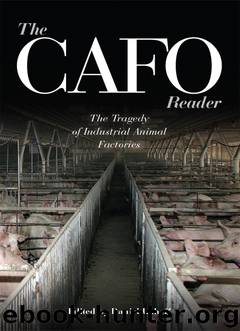The CAFO Reader by Daniel Imhoff

Author:Daniel Imhoff
Language: eng
Format: epub
ISBN: 9780984630417
Publisher: Watershed Media
A BLUR OF CHICKENS
Even speedier than the slaughtered pig or cow, the dead chicken may be the fastest animal in North America. From “catchers,” to “hangers,” to “evisc” (short for evisceration), the processing of roughly 9 billion chickens each year—meeting increased demands for cheap, versatile meals and slimmer hips—rests on low wages and treacherous speed. The typical poultry factory can, in a single eight-hour shift, turn 144,000 birds into packages of “RTC” (“ready to cook”) chicken.
Amid clouds of ammonia and fecal matter carrying salmonella and other harmful bacteria, immigrant chicken catchers wade into 100-degree holding pens bustling with frantic, desperate birds. Dodging sharp beaks and claws, the catchers grasp the birds by their feet—generally snaring about 8,000 chickens a day—and hurl them into cages destined for the processing plant. Many catchers fall prey to cuts, eye infections, and respiratory ailments—not to mention enduring the constant urination of terrified chickens. At the factory, “hangers” attach the feet of up to 50 birds a minute (more than 20,000 a day) into metal shackles so that a razor-sharp wire just down the line can lop off the dangling heads efficiently. Rotator cuff and other repetitive motion injuries are widespread among hangers.7
After being scalded in huge vats of hot water to enable rapid plucking, the birds blast down the line to the evisceration section. Here, while most plants now gut chickens by machine, some workers perform “evisc” by hand—twisting and pulling the innards from 35 or more chickens a minute. In some plants, workers make up to 100 evisceration cuts a minute. Farther down the line, workers in “debone” stand shoulder-to-shoulder, slicing and chopping their way through joints, tendons, and tough gristle to produce the most popular chicken part on the market—boneless chicken breasts. The process here “slows” to 20 or 30 hard twisting motions a minute. Scissors and knives quickly dull, and workers routinely lacerate themselves or their neighbors when blades slip off the slimy carcasses. Disabling carpal tunnel syndrome and other repetitive stress disorders are common.
As annual chicken consumption has soared from 40 pounds per person in 1970 to 75 pounds today, the government has allowed industry to crank up assembly line speeds. According to research by attorney Marc Linder, corroborated by government documents, the poultry industry lobbied President Reagan’s USDA to increase factory line speeds from an already blinding 70 birds per minute to today’s astounding rate of 91 per minute. (The mere fact that the U.S. Department of Agriculture sets line speeds should be disconcerting, as the agency’s mission is to spur food production, not to protect workers’ safety.)
During this intense speed-up, according to Linder, repetitive stress ailments skyrocketed. “Between 1980 and 1993, repetitive trauma disorders, as a proportion of all newly reported occupational illnesses, rose from 18 percent to 60 percent. The poultry processing industry recorded the second-highest incidence of repetitive trauma disorders in 1990—696 per 10,000 full-time workers. The highest incidence was recorded in the related meat packing industry.” Government meat inspectors were not immune: “The USDA’s admission
Download
This site does not store any files on its server. We only index and link to content provided by other sites. Please contact the content providers to delete copyright contents if any and email us, we'll remove relevant links or contents immediately.
| Anthropology | Archaeology |
| Philosophy | Politics & Government |
| Social Sciences | Sociology |
| Women's Studies |
The Secret History by Donna Tartt(18087)
The Social Justice Warrior Handbook by Lisa De Pasquale(11943)
Thirteen Reasons Why by Jay Asher(8418)
This Is How You Lose Her by Junot Diaz(6412)
Weapons of Math Destruction by Cathy O'Neil(5802)
Zero to One by Peter Thiel(5464)
Beartown by Fredrik Backman(5310)
The Myth of the Strong Leader by Archie Brown(5219)
The Fire Next Time by James Baldwin(4998)
How Democracies Die by Steven Levitsky & Daniel Ziblatt(4941)
Promise Me, Dad by Joe Biden(4900)
Stone's Rules by Roger Stone(4836)
100 Deadly Skills by Clint Emerson(4668)
Rise and Kill First by Ronen Bergman(4537)
A Higher Loyalty: Truth, Lies, and Leadership by James Comey(4534)
The David Icke Guide to the Global Conspiracy (and how to end it) by David Icke(4362)
Secrecy World by Jake Bernstein(4357)
The Farm by Tom Rob Smith(4308)
The Doomsday Machine by Daniel Ellsberg(4234)
